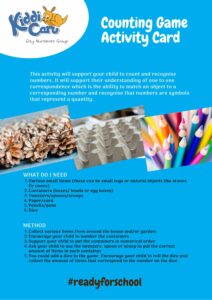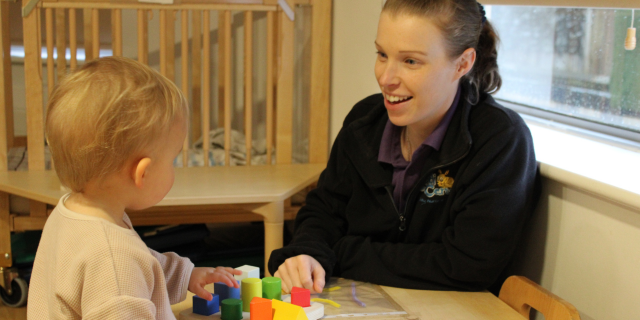School Readiness at Home
School Readiness Programme: I like counting
School Readiness at Home

At Kiddi Caru Day Nurseries Group, the preschool children can engage in a wide range of high quality opportunities to develop their mathematical understanding and vocabulary. This includes maximising the mathematical potential within everyday routines, as well as providing opportunities for children to pose and solve mathematical problems within both the indoor and outdoor environment, for example at snack time the helper may be asked, “How many cups do we need today?”
We try to encourage the children to notice that maths is everywhere, modelling the use of mathematical language in everyday use, for example singing counting songs and rhymes, such as ‘5 Little Men in a Flying Saucer’. As well as posing open ended questions like, “What would happen if…?” or “How do you know that …?”
Talking to your child is important to help them learn the language of mathematics. The English language is often confusing because some words have the same sound but more than one meaning. For example, ‘to’, ‘two’, and ‘too’ sound the same to a child but have a variety of meanings. It is important that mathematics language is used accurately. Listen carefully to your child to discover their understanding of language.
Mathematics in the Early Years Foundation Stage framework is divided into two aspects:
- Numbers
- Shape, space and measure
Rhymes and stories are a rich source of mathematical language and allow children to delight in repetition which plays an important part in learning.
Some of our favourites include:
- Five little speckled frogs
- Five currant buns
- Five teddies sitting on a wall
- Ten in a bed
- Ten green bottles
- Ten little monkeys jumping on the bed
- Five little ducks
- Five little men in a flying saucer
- 1, potato, 2 potato, 3 potato, 4
- One, two, buckle my shoe
- One little elephant went out to play
- Ten fat sausages
- 1,2,3,4,5, once I caught a fish alive
Numbers
It is important for children to gradually know and use numbers and count throughout play during their early year, to recognise and use numbers reliably, develop mathematical ideas and to solve problems. It is easy to think of a child understanding number when reciting numbers out loud. This is a useful skill but means very little in itself. Children need to come to know what the number system really means.
We want children to:
- Know the sequence of numbers
- Understand 1-1 correspondence
- Understand ordinal numbers; 1st, 2nd, 3rd
- Understand the conservation of number, for example the ‘threeness of three’. Three is always three no matter how it is arranged or presented, whether it is the numeral 3, three bricks, three buttons on a coat or the three bears.
Shape, space and measure
This area of learning involves children learning to use everyday language to talk about size, weight, capacity, position, distance, time and money to compare quantities and objects and to solve problems. They will develop their ability to recognise, create and describe patterns. Children need to be encouraged to explore the characteristics of everyday objects and shapes and use mathematical language to describe them.
You can help your child develop in each of these area at home with our activities. Remember that all these activities should be fun and interactive. Give your child lots of encouragement and cuddles as you play alongside. Smiles and praise will help develop a sense of achievement and build confidence.
Activity: Number Skittles
This activity will support your child to count and to recognise numbers. Learning about number and counting language, working memory and visualisation. Children learn best through real life experiences and can be incorporated during every day activities like setting the table, counting buttons when dressing, climbing the stairs and counting finger and toes.

Download
Activity: Counting Game
This activity will support your child to count and recognise numbers. It will support their understanding of one to one correspondence which is the ability to match an object to a corresponding number and recognise that numbers are symbols that represent a quantity.

Download
Activity: Counting Pegs
Pegs are always a fascinating object to young children as they can practise their dexterity and fine motor skills, whilst understanding the relationship between matching written numbers to objects in the fun game.

Download
Share this article
Related blog/news
Swipe to see our latest articles.








